Wall Street believes that a slowdown in U.S. inflation could put an end to the strong rally of the U.S. dollar.
New data from the U.S. Bureau of Labor Statistics shows that the year-on-year increase in the U.S. Consumer Price Index (CPI) in June continued to fall from 4% in May to 3%, lower than the predicted 3.1%. This marked a 12-month decline and the lowest point since March 2021. The year-on-year growth rate of the Producer Price Index (PPI) in June slowed down from 1.1% in the previous month to almost no growth at 0.1%, lower than the anticipated 0.4% and a record low since August 2020.
Following these two data points falling below predictions, market consensus suggests that the Federal Reserve could end its rate-hiking cycle. The market currently predicts the Federal Reserve will raise rates by 25 basis points in July and will not implement any further rate hikes before the end of the year. Rate cuts are expected to begin in January 2024.
On Thursday, the dollar index fell for the sixth consecutive day, accumulating a total decrease of 4.5%. This marks the longest streak of decline since July 2020 and the largest decrease since November 2022, bringing the index back to pre-pandemic levels.
All three major U.S. stock indexes closed higher, with large tech stocks continuing to rise. The Nasdaq index ended up 1.58% and the S&P 500 index also closed 0.85% higher, both reaching their highest levels since April of last year for two consecutive days. The S&P 500 index is now 3% higher than when the Federal Reserve first raised rates in March 2022.
U.S. bond yields fell sharply across the board. The yield on the 2-year U.S. bond fell more than 50 basis points from last week's high, and the inversions of the 5-year and 30-year U.S. bond yields noticeably weakened.
After a decade-long rise that accelerated in 2022, investors have been anticipating a drop in the U.S. dollar this year. However, as U.S. inflation turned out to be more stubborn than many had predicted, the dollar's upward trend did not cease in recent months.
With inflation continuing to cool down, it seems the opportunity has finally arrived. Some investors believe that Wednesday's CPI data gave them a reason to short the U.S. dollar once again.
According to a Bloomberg report, Steve Englander, a strategist at Standard Chartered Bank, described the inflation data as a "game changer" for global currencies, while George Saravelos, head of foreign exchange research at Deutsche Bank, advised clients to sell the U.S. dollar in a report.
Saravelos implied that the U.S. inflation data released that day provided the final evidence they had been waiting for.
In theory, a halt to the dollar's upward trend would ease pressure on other countries. This is because it makes it easier to repay debt denominated in dollars and lowers the purchase prices of imported products priced in dollars, such as oil and wheat.






